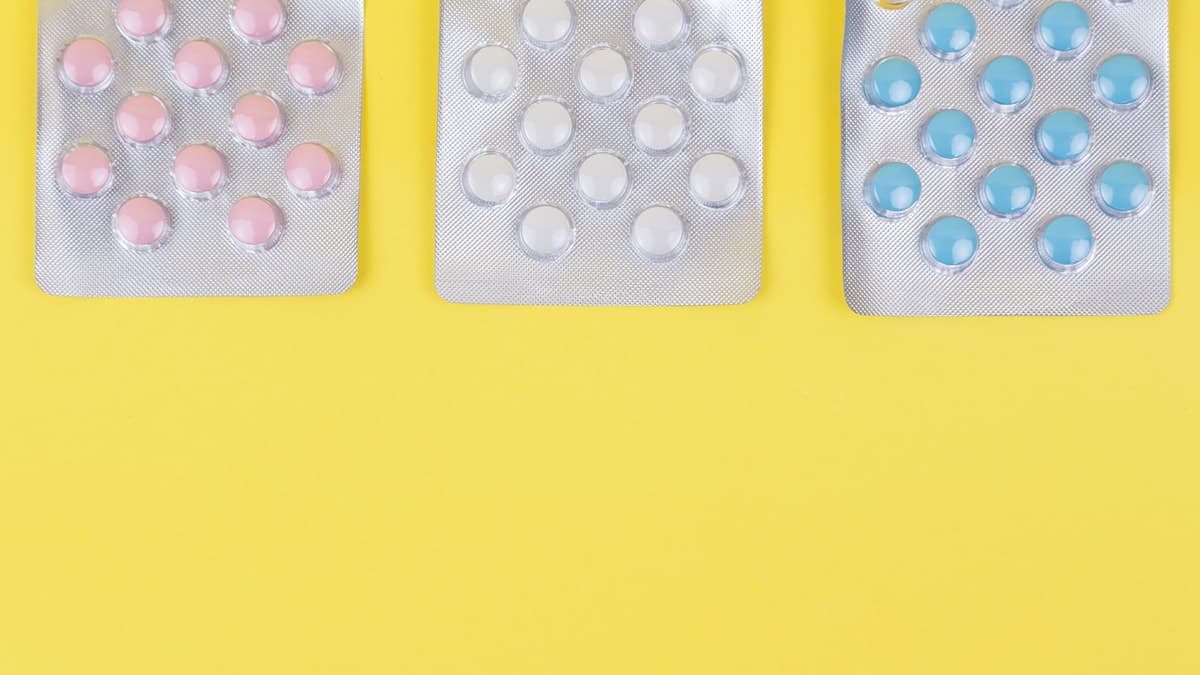How to Save Money on Menopause Medication
high drug prices

It’s estimated that 1.3 million women enter menopause every single year. Given that it’s something every woman goes through sooner or later, it’s strange that it remains such a taboo topic. Making matters even more strange, 44% of women experiencing perimenopausal symptoms took some form of menopause medication.
Perhaps in part because it’s a surefire sign of aging, or perhaps because it’s the official end of a woman’s childbearing years, or maybe even just because it’s women’s health (as opposed to men’s health), menopause is a topic no one seems to want to discuss. Much like most women’s health issues, women are expected to suffer in silence.
The fact of the matter is that menopause can be disruptive to women's lives. Mood swings, hot flashes, night sweats, poor sleep, and discomfort during sex can severely impact women’s mental health, as well as their physical health.
Fortunately, researchers have developed quite a few prescription medications for menopause that have proven to be very effective at treating the most common symptoms.
Here are the signs that you’re entering menopause and how you can save money on the medications that can help you through it more easily.
How Will I Know if I’m in Menopause?
It’s tricky to determine if you’re actually in menopause, or if you’re exhibiting signs of perimenopause. Like most other natural health events for women, figuring out where your body is in this process can be rather confusing — even for your primary care physician (PCP) or obstetrician-gynecologist (OB-GYN).
The confusion often stems from the length of time involved in menopause, the age range in which it can occur, and inconsistent symptoms. Because genetics play a significant role in when you might go through menopause (i.e. when your mom, sisters, grandmothers, aunts went through it), having a comprehensive family medical history can help your PCP and OB-GYN figure out what’s going on with your body.
Natural menopause is officially diagnosed when an entire year has passed since a person last menstruated. The average North American woman is about 51 when menopause is determined, but it can occur anytime between the ages of 40 and 58 (though there are certainly outliers in both directions).
It’s entirely possible for people to experience early menopause due to medical intervention, surgical procedures, or treatment for a condition affecting reproductive organs. However, in those cases, the symptoms are more easily diagnosed.
PCPs and OB-GYNs will already know the probability of early menopause due to a course of treatment and can warn their patients of possible symptoms. It’s naturally occurring menopause that is so difficult to diagnose.
If menopause is naturally occurring, there are three stages.
Perimenopause
In naturally occurring menopause, the first signs that you’re nearing that marker are irregular periods (although some women experience these during their childbearing years, as well), hot flashes, vaginal dryness, poor sleep (because of hot flashes, in many cases), and mood swings.
These early symptoms are known as perimenopause and are a result of estrogen levels changing in the body. Menopause is essentially the body decreasing the amount of estrogen it makes, which eventually forces menstruation to stop because the ovaries stop releasing eggs. (If there’s no unfertilized egg to release, there’s no reason for a period.)
Perimenopause can last for years but is most commonly one or two years.
Menopause
Menopause cannot be officially diagnosed until there has been a full year without a menstrual cycle. If someone has gone months without a period, it is possible that they’re experiencing menopause, but again, it won’t be official until a full year has passed.
This is what makes a menopause diagnosis so tricky. There is no way to tell if you’re actually in it until a certain amount of time has passed.
In the meantime, you may still experience the same symptoms you experienced during perimenopause.
Postmenopause
Postmenopause is simply characterized by the diagnosis of menopause that confirms menstruation is over. Symptoms like vaginal dryness and hot flashes may still happen for years to come.
While prescription medication is used to treat symptoms of menopause during all three stages, postmenopause is a time when it’s rather important. Having decreased estrogen levels in the body increases your risk of developing conditions, such as osteoporosis and heart disease.
Menopause medication can help decrease the risk of developing such conditions by supplementing your estrogen levels. This practice is also known as hormone replacement therapy (HRT).
On the non-life-threatening side, there are also prescription medications that can help with vaginal dryness.
Here are the best (and most popular) medications for menopause.

Prescription Medication for Menopause
Menopause medications can come in a few different forms, such as patches, gels, creams, and oral tablets. The form will depend on the purpose of the medication and how researchers have determined it’s most effective.
Vivelle Dot
The Vivelle Dot (also called Estradot, as marketed in Canada) is a patch, similar to a nicotine patch or a birth control patch in that it is applied to clean skin. Each patch should be removed every three to four days — about twice per week. A pack of eight patches should last about one month.
The active ingredient in Vivelle Dot (Estradot) is estradiol, which is a type of estrogen. This specific type of estrogen is a synthetic version of what your body naturally produces in the ovaries. This is one reason that ethinyl estradiol is commonly found in birth control pills.
Because the Vivelle Dot is applied directly to the skin, estradiol is absorbed through the dermis and circulated through the body. By increasing the estrogen levels in the body, hot flashes and vaginal dryness may improve, in addition to decreasing the risk of osteoporosis.
In the United States, the cash price of an 8-pack of Vivelle Dot patches is about $174.00, or about $22.00 per patch. There are generics being released that sell for as little as $90.00 for an 8-pack, or about $11.25 per patch.
At NorthWestPharmacy.com, we sell Vivelle Dot (Estradot) for as little as $38.00 for an 8-pack, or about $4.75 per patch.
Estrace
Estrace uses the same active ingredient as Vivelle Dot (estradiol) but it’s an oral medication that is taken in a pill-form. It should be taken once per day, ideally at the same time every day.
In the United States, brand name Estrace costs about $219.00 for a one-month supply, which comes down to about $7.30 per pill. The generic versions are much more affordable — about $10.00 for a one-month supply, or about $0.33 per pill.
At NorthWestPharmacy.com, we have brand-name Estrace for about the same cost as the generic in the U.S. Estrace starts at about $33.00 for 100 tablets, which is about $0.33 per pill. The generic version is slightly cheaper still — about $27.00 for 100 tablets, or about $0.27 per pill.
Estring
Estring also utilizes estradiol but takes the form of a vaginal ring. Estring is inserted into the vagina by either the patient herself or her doctor — whichever she prefers. The device releases steady amounts of estradiol over a period of 90 days.
Because it’s a local estrogen therapy, it has been clinically proven to treat menopause symptoms associated with atrophic vaginitis. Estring should help relieve moderate-to-severe pain during sex, burning, itching, dryness, and painful urination caused by postmenopausal changes.
Estring was initially approved in 1996, but there are still no generics available. Of course, this means it’s pretty expensive. In the U.S., you can expect to pay a cash price of about $550.00. Since one ring lasts for three months, this works out to be about $184.00 per month.
At NorthWestPharmacy.com, we sell Estring for about $105.00, which is only $35.00 per month.
EstroGel
EstroGel (also estradiol) is a topical gel applied to the skin, but in a smaller dose than most other hormone replacement products. A lower dose of estradiol typically means fewer side effects, so that can be a reason that women want to try it.
Like the Vivelle Dot (Estradot), it’s a topical treatment, but it’s not in a patch. Instead, a dose of the gel is applied to the arm once per day. It’s odorless and colorless, and once it is absorbed by the skin (about five minutes), you can get dressed like normal.
In the U.S., a 52-gram bottle (or 2-26 gram bottles) of EstroGel costs about $286.00. At this time, there is no generic version available.
At NorthWestPharmacy.com, you can get an 80-gram bottle of EstroGel for about $40.00.
Vagifem
Vagifem also utilizes estradiol as its active ingredient but is different in its form than the others on the list. Vagifem is a tablet that is inserted into the vagina, where it dissolves.
This hormone replacement therapy is targeted toward a menopause-related condition called vaginal atrophy. This is when vaginal tissues get thinner and therefore, more easily irritated, which can lead to various forms of discomfort, such as dryness and itchiness. Of course, any combination of these symptoms can lead to painful intercourse.
Vagifem is popular among women who are no longer having hot flashes or night sweats, but are suffering from painful sex. Because this menopause medication is topical in application, less of it is likely to enter the bloodstream. Furthermore, its location-specific application can help moisturize the tissue over time.
This prescription medication is rather expensive. In the U.S., the cash price of Vagifem starts at about $223.00 for eight tablets, or about $28.00 per pill. A pack of 18 tablets start around $450.00, or $25.00 per pill.
At NorthWestPharmacy.com, we sell Vagifem starting at about $70.00 for 18 tablets, or $3.89 per pill.
Premarin
Unlike the other medications on this list, Premarin is made up of something called “conjugated estrogens,” which means it contains multiple different types of estrogen hormones (as opposed to only one).
Premarin comes in a couple of different forms — oral tablets and a topical cream. There is no generic version available at this time.
In the U.S., the cash price of a one-month supply of Premarin will cost about $240.00, or $8.00 per pill.
At NorthWestPharmacy.com, we sell Premarin tablets in a 28-day supply for about $28.00, or $1.00 per pill.
The topical cream is applied directly to the vagina. In the U.S., Premarin topical cream typically comes in a 30-gram tube and costs about $462.00.
At NorthWestPharmacy.com, we sell Premarin topical cream in two different sized tubes. The 14-gram tube costs about $28.00, while the 30-gram tube costs about $60.00.

Getting Started with a Canadian Online Pharmacy
Women who are hoping to find their menopause medication at a more affordable price could do so by looking into an international and/or Canadian online pharmacy. While some generic medications may be reasonably priced in the United States, brand name medications are notoriously overpriced.
Each branded medication is different, but most of our customers find that they can save between 20% and 90% each month on their prescriptions, regardless of the classification.
Of course, the reason for this is the exorbitant prices pharmaceutical companies charge within the USA. As healthcare becomes increasingly expensive and the baby boomers (a significant portion of the population) are becoming senior citizens, the price of prescription medications is becoming a bigger problem by the day.
At NorthWestPharmacy.com, we’re dedicated to safety, customer service, and low prices — and it shows in our over 475,000 positive online reviews and our 4.8/5 overall rating on Shopper Approved.
If manufacturer’s coupons aren’t doing you the favors you expected them to (they rarely do) and are in need of a reliable online pharmacy, give us a call today at 1-866-539-5330. Again, we’re dedicated to customer service, so our call center is open seven days a week to answer your questions or help you place your order.
You can talk to a pharmacist any time, as well. Some of our customers have specific questions about possible drug interactions, and our knowledgeable pharmacists are happy to help.
And if you need to reach us outside of business hours, you can always do so by emailing us. We’ll get back to you as soon as possible.